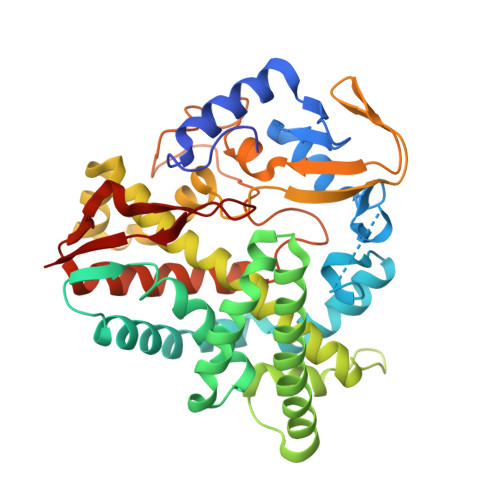P450-Mediated Non-natural Cyclopropanation of Dehydroalanine-Containing Thiopeptides.
Gober, J.G., Ghodge, S.V., Bogart, J.W., Wever, W.J., Watkins, R.R., Brustad, E.M., Bowers, A.A.(2017) ACS Chem Biol 12: 1726-1731
- PubMed: 28535034
- DOI: https://doi.org/10.1021/acschembio.7b00358
- Primary Citation of Related Structures:
5VWS - PubMed Abstract:
Thiopeptides are a growing class of ribosomally synthesized and post-translationally modified peptide (RiPP) natural products. Many biosynthetic enzymes for RiPPs, especially thiopeptides, are promiscuous and can accept a wide range of peptide substrates with different amino acid sequences; thus, these enzymes have been used as tools to generate new natural product derivatives. Here, we explore an alternative route to molecular complexity by engineering thiopeptide tailoring enzymes to do new or non-native chemistry. We explore cytochrome P450 enzymes as biocatalysts for cyclopropanation of dehydroalanines, chemical motifs found widely in thiopeptides and other RiPP-based natural products. We find that P450 TbtJ1 and P450 TbtJ2 selectively cyclopropanate dehydroalanines in a number of complex thiopeptide-based substrates and convert them into 1-amino-2-cyclopropane carboxylic acids (ACCAs), which are important pharmacophores. This chemistry takes advantage of the innate affinity of these biosynthetic enzymes for their substrates and enables incorporation of new pharmacophores into thiopeptide architectures. This work also presents a strategy for diversification of natural products through rationally repurposing biosynthetic enzymes as non-natural biocatalysts.
- Department of Chemistry, University of North Carolina at Chapel Hill , Chapel Hill, North Carolina 27514, United States.
Organizational Affiliation:

















